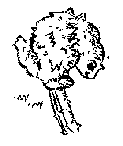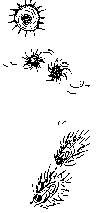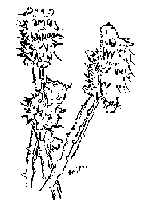(See copyright info at end)
I LIKE TEASELS
Teasels are wild plants
Nodding at the edge of ditch or swamp;
Grown-ups call them "bad weeds",
And say, "Don't let teasel seeds loose
in my garden!"
But I like teasels.
Teasels have lots of seeds, I grant.
Also, they are spiny plants!
God made them grow in damp places.
I can take my knife and whittle the stalks
(And not even have to ask somebody's pardon!)
The prickled heads are beautiful even after they seem dead,
The brown stems sometimes standing higher than my head.
Yes, I like teasels!
IMAGES IN TARES

I guess God made tall teasels
To tease my imagination----
The glint of teasels' prickles
Through bright sunshine, is lacy gold!
Then again, teasel-heads on spiny stems
Are like tiny porcupines begging, very bold.
In spring, pink-tinged green leafage
shouts, "God is Wonderful!"
After winter rains, new fragile shoots
Arise right in old brown pods --
growth over-full!
Tares, folks call them: common teasel-weeds.
But cut a teasel open -- it's a surprise!
Inside are stars, whirligigs, even "eyes".
Teasels are useless tares to burn, outcast;
Yet hidden artistries of image-work
Lie buried in the prickery husks,
Just waiting for my discovery, I surmise.
Yes, shapes seen in tall teasels
Stir up my imagination----

THE PRICKLES OF TEASELS
Teasels are weeds
That thrive in dank, moist places.
The sunshine on spiked heads
Weaves silver and dark spaces;
Sun sifts through prickles,
Creating haloed, golden spaces.
Spines interweave
Like gold threads. (At several paces,
If I squint really hard,
I think I "see" sunshiny "faces".)
When sun falls on prickles,
There is such tender light:
The play of warm gold
Turns autumn-brown teasels wondrously bright.

TEASELS, ROSE HIPS, AND BARBED WIRE
(Observation from the last of January, 1978)
Teasels grow rampantly along a meandering country road. The
dried heads have many needlelike, barbed points. At this time of
year, the tall, prickly plants are usually dried and brown and
rattly -- or showing weather stains. Eventually, the old stock
will fall to the ground where it discharges its multitude of new
seeds.
This year, however, there's been so much rain, but mild
temperature, that seeds have sprouted right inside the teasel
heads. What a novelty, to see teasels very green, and not normal
brown. For the head is covered with new shoots, each with two tiny
green leaves much less than a half inch high. So the teasels are
greenish ovals with the old brown spikelets protruding through.
The green shoots grow more lushly on the side which the
fencerows shade, where the plant doesn't get as much light.
Wild rose vines also line the fenceposts at roadside. After
the rose blossoms die, the firm, orangy red rose hips emerge. By
January, some of the rose hips have started to to turn brown. Some
are still red, and look quite wonderful. But when I touch the red
ones, or look at them closely, I notice how they've started to
soften.
Still, the bright seed pods are red enough to make a splash of
color against the bare rosevines all twining around the barbed
wire. Greeny-brown teasels. Red rose hips on tangles of brown
spiked stems. The tumble of ubiquitous Oregon blackberry vines.
Fencerows growing up to tall grass; slivery fenceposts and rusty
wire. Taken together, a picturesque view, a cheerful "country"
scene.
EMERALD GREEN
(observation last of January, 1978)
The grass is coming up in the pastures beyond the barbed wire
fences. Such a rich, emerald green color,
yet with none of the "hardness" of crystal gems.
The grass, tenacious, can't be beaten back by rainwater
puddling many fields. The standing water in some of the back
fields is far enough away so that you can't really see what it
looks like, or define its true colorings. So the whole world has
closed down to two hues: blissful green-green-green grass, and the
water with a kind of glossy shimmer: almost whitish blue-gray.
Oh what rest for the soul! My eyes drink in the scene, and my
senses are as satisfied as if I'd had a drink of cool, clear water
or tasted a tangy after-dinner mint.
--
copyright 1981 and 1997 by Marilee Miller
copying or reproduction is limited to personal enjoyment and
to share with a few friends; no mass production or for-profit use.